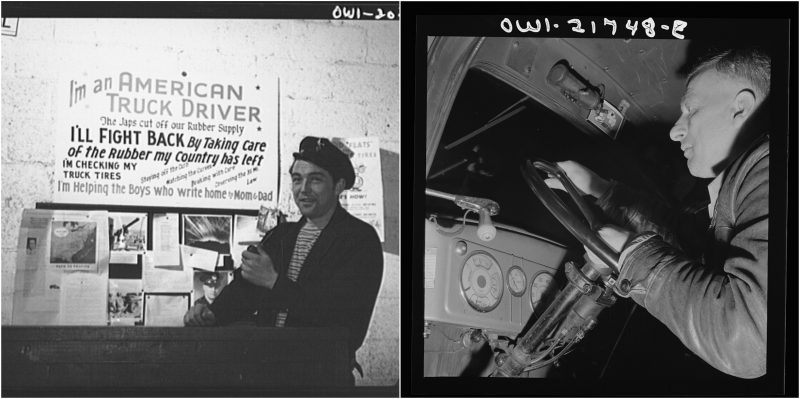Truck drivers have always been a symbol of free spirits, adventure, and struggle. Truck drivers and their trucks have indirectly changed the way our society works. By transporting goods from place to place, they have brought a whole new era of globalization.
The portrayal of the trucking industry in United States popular culture spans the depictions of trucks and truck drivers, but images of the masculine side of trucking are a common theme. Songs and movies about truck drivers were first popular in the 1940’s, and mythologized their wandering lifestyle in the 1960’s. Truck drivers were glorified as modern day cowboys, outlaws, and rebels during the peak of trucker culture in the 1970’s.
The following pictures of American truck drivers from the 1930’s and 1940’s are part of a huge 170,000 photos collection that is kept in the Library of Congress. The photos were taken by the Information Division of the Resettlement Administration (RA). The RA was established In 1935 by Franklin Delano Roosevelt. it was supposed to relocate hundreds of thousands of farmers from the exhausted land and migrant laborers to viable land in planned communities purchased with low-interest loans. Truck drivers had a huge role in this process of relocation.



The 1930’s and 1940’s were a changing point for the trucking industry in the US. That were the years when truck driving got standardized. In 1933, as a part of President Franklin D. Roosevelt’s “New Deal”, the National Recovery Administration requested that each industry creates a “code of fair competition”. By the summer of 1933, the code of competition for the trucking industry was completed. The American Trucking Association was also formed that year. The first president of the ATA, Ted Rogers, became the first truck operator to sign the code. A special “Blue Eagle” license plate was created for truck operators to indicate compliance with the code. Congress enacted the first hours of service regulations in 1938, limiting the driving hours of truck and bus drivers.




In the early days of trucking culture, truck drivers were more frequently portrayed as protagonists in the popular media. In his book, Trucking country: The road to America’s Wal-Mart economy, author Shane Hamilton said:
“The first original song about truck driving appeared in 1939 when Cliff Bruner and His Boys recorded Ted Daffan’s “Truck Driver’s Blues,” a song explicitly marketed to roadside cafe owners who were installing jukeboxes in record numbers to serve truckers and other motorists.”
The 1940 film They Drive by Night co-starred Humphrey Bogart as an independent truck driver struggling to become economically independent during the Great Depression. The Gang’s All Here was a story about a trucking company targeted by saboteurs, released in 1941.





















In the 1950’s, truck drivers were considered the “Knights of the Road” for helping stranded travelers. Drivers were viewed as the antithesis of “The Organization Man” (the title of William H. Whyte’s 1956 bestseller) or “the man in the gray flannel suit”, who sat in an office every day or was watched over by managers. Popular trucking songs glorified the life of drivers as independent “wanderers” while attempts to bring factory-style efficiency (using tachographs) to trucking met with little success. Drivers routinely sabotaged and discovered new ways to falsify the machine’s records.
